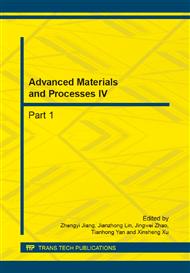p.74
p.78
p.82
p.86
p.90
p.94
p.98
p.103
p.108
The Electrochemical Behaviors of HSn70-1A Brass in Polluted Freshwater
Abstract:
The corrosion behaviors of HSn70-1A brass in polluted freshwater were investigated by electrochemical measurements. Results of immersion experiments in eutrophic freshwater and pollution-free water showed that the dissolved oxygen content in the water was a key factor in determining the corrosion rate of HSn70-1A brass. Because the dissolved oxygen content in the polluted freshwater was lower than that in pollution-free freshwater, the corrosion rate of HSn70-1A brass in polluted freshwater was also lower than that in the pollution-free water. Moreover, electrochemical measurements in simulated freshwater showed that phosphoric compounds had an inhibiting influence on the corrosion of HSn70-1A brass while the nitric compounds had little this inhibiting effect.
Info:
Periodical:
Pages:
90-93
Citation:
Online since:
September 2014
Authors:
Price:
Сopyright:
© 2014 Trans Tech Publications Ltd. All Rights Reserved
Share:
Citation:


